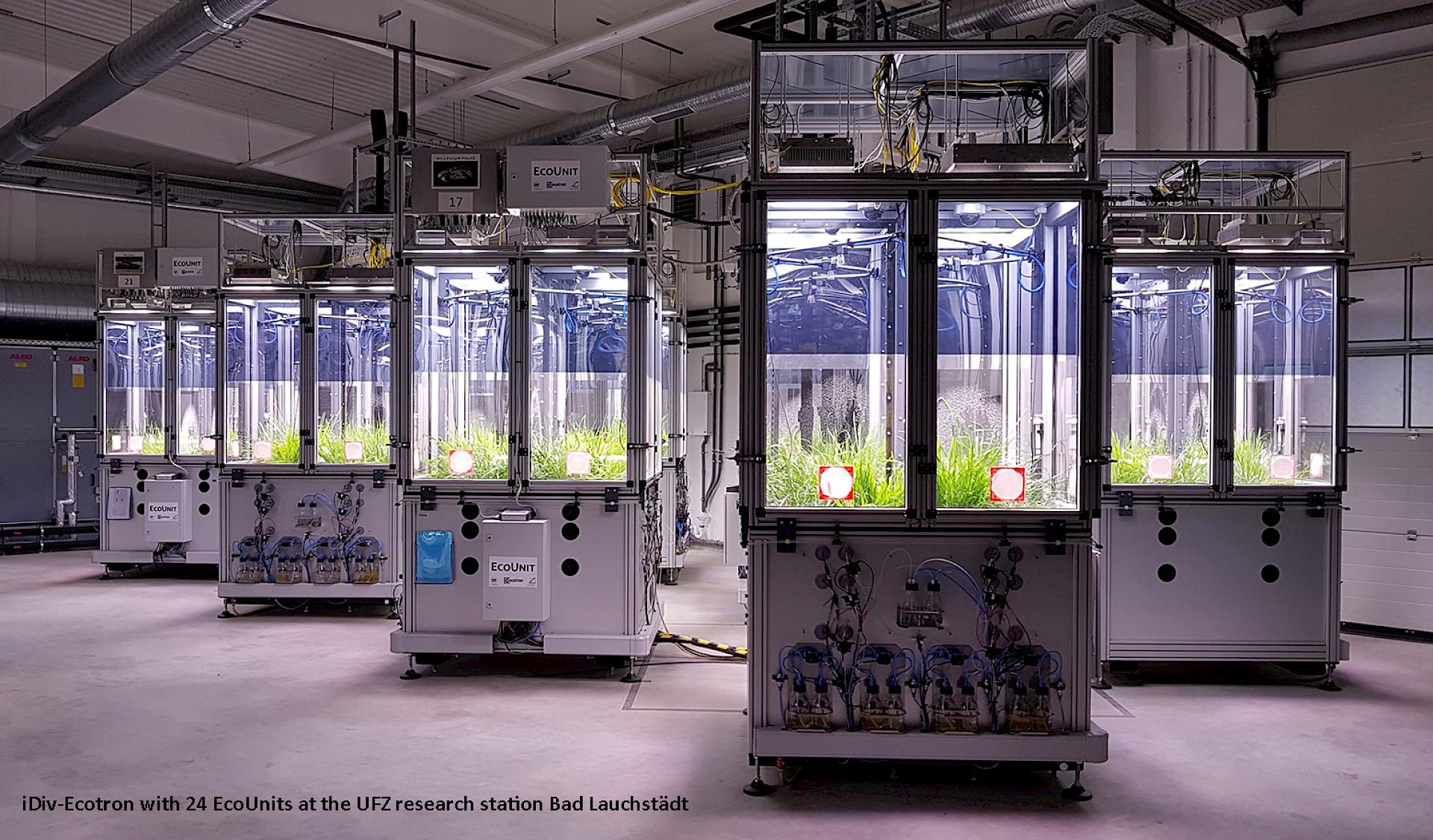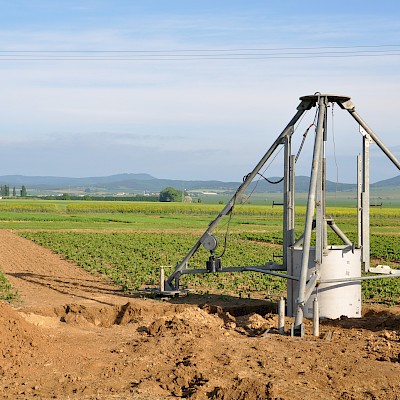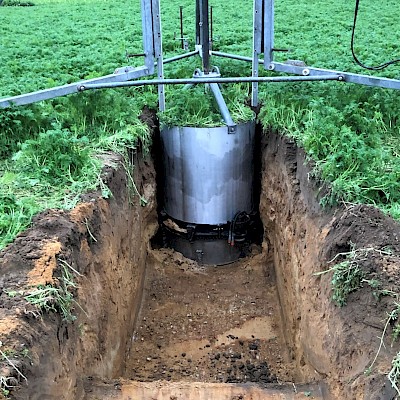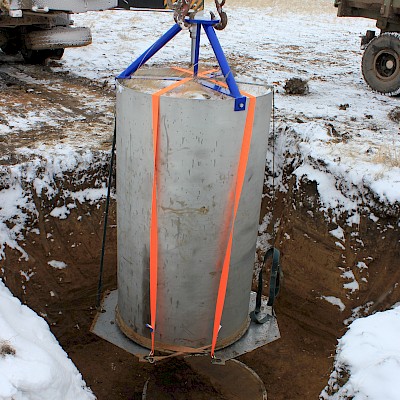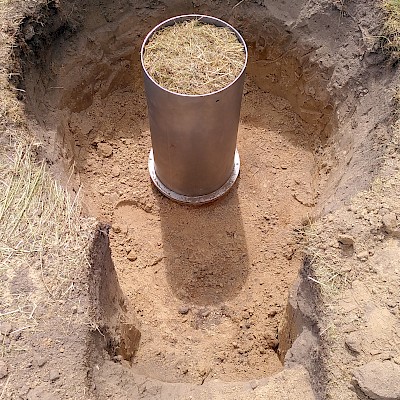Product overview
Lysimeter sampling technique
If you want to investigate the water balance variables of real soils from the landscape, use our proven lysimeter sampling technique. We have the necessary expertise and over 30 years of experience in the development and handling of special equipment and procedures to extract undisturbed soil monoliths in small and large lysimeters in the field for your questions.
Our products in Lysimeter sampling technique
Our sampling technologies
With the unique extraction technology for mineral soils developed by UGT, soil columns can be extracted with high precision and undisturbed soil structure without the use of heavy technology. The contour of the soil monolith is precut using a milling device that is guided concentrically around the lysimeter vessel. As a result, the lysimeter vessel takes on the shape of the soil column as it is lowered. The results of X-ray and computed tomography studies have shown that soil monoliths sampled using this method do not exhibit any cracks or structural changes. This technology can be used to extract soil monoliths with diameters ranging from 300 to 1596 mmm (2 m²) and is operated exclusively by our UGT personnel.
For the challenges that organic soils, especially peatlands, pose to monolith extraction, patented extraction technologies for organic soils in column form have been developed on the one hand (Patent No.: 10 353 485; 10 2011 006374 for organic - soils and peatlands) and on the other hand special lysimeter vessels and extraction technologies for organic soils adapted to them.
In order to be more flexible in your planning, UGT has modified the sampling technology in such a way that you as a user can independently sample undisturbed soil monoliths with diameters between 200 and 1128 mm (1 m²). In particular, this completes our "Ready-To-Go Lysimeter" product line, which has gained worldwide acceptance as user-friendly lysimeter stations. The combination of "Ready-To-Go Lysimeters" and "Ready-To-Go Monolith Sampling-Basic" allows you to set up your small lysimeters and small lysimeter stations completely self-sufficient.
If you want to sample even smaller undisturbed soil columns with a diameter of 100 to 200 mm and max. 600 mm depth in the field, we recommend our "Mobile device for sampling undisturbed soil columns".
Advantages
- Undisturbed soil monoliths
- No deformations of the monolithic soil structure due to compression or pressing
- No structural changes due to impact of the lysimeter vessel
- Avoidance of edge runnings between soil monolith and lysimeter vessel due to tools specially adapted to the soil
- Avoidance of ground fractures in the monolith due to axial guidance of the aligned lysimeter vessel to the sampling depth
- Lightweight, mobile sampling technique as a prerequisite for use in difficult terrain conditions
- Easy relocation of the sampling technique, e.g. when encountering quality-impairing obstacles such as large stones, deposits or the like at the site
- Well-visible soil profile due to intact extraction pits, thus possibility for profile approach and soil mapping after monolith extraction
- Minimal land consumption due to small distances between removal points
- Low site disturbance
Things to know about the lysimeter sampling technique
No special requirements are placed on the condition of the terrain. However, a sufficiently large area must be ensured. Especially in case of obstacles in the soil, it should be possible to pierce at an adjacent location.
In the field, the lysimeter vessel with the soil monolith is installed at the same location where the soil monolith was pricked. Therefore, site selection prior to piercing is very important. For solar powered lysimeter stations, care must be taken to ensure that the solar panel can face south.
Overall, the use of lightweight technology minimizes the impact on the removal site. The process is very space-efficient so that the surrounding area is affected as little as possible during the removal of the soil columns.
After reaching the sampling depth, the lysimeter vessel is dug free. When the soil monoliths are dug free, the topsoil (approx. 0 - 30 cm) and the subsoil are stored separately. Afterwards, the soil column is separated from the surrounding soil area by means of shear plates or shear lamellas. Subsequently, the shear plate or the shear lamellae serve as a temporary closure of the lysimeter vessel, so that the soil monolith can be securely lifted out of the extraction pit after separation. Depending on the height and diameter of the lysimeters used, the removal of the soil monolith can be carried out by personal force or by means of lifting technology or an excavator.
After the successful sampling of the undisturbed soil monolith in a lysimeter vessel, the installation of the measurement technology takes place. Depending on the application, the installation of the measurement technology is carried out either in the laboratory, e.g. when used in an Ecotron, or on site in the field, e.g. in a lysimeter station or in a Ready-To-Go Lysimeter. For this purpose, the lysimeter vessel is closed with a lid. The gap between the bottom surface and the lid is padded with material to prevent the bottom monolith from slipping during turning. The lysimeter is then rotated using personal force or a round turning collar. The use of a turning collar minimizes the occurrence of shear forces and thus a change of the soil monolith. The lysimeter vessel must be turned over in order, on the one hand, to dismantle the shear plate and, if desired, to install the suction probe system for the lower boundary condition. The lysimeter vessel is then closed with a bottom lid with a seepage valve. The lysimeter vessel is now turned upside down again.
Now the sensors can be installed one by one with simple hand movements. For each sensor type, there are special pre-drills that can be used to drill the exact depth and the correct diameter. The correct procedure for drilling and installing the sensors is important to ensure a good connection between the soil and the sensors. Especially with the Tensiometer it has proven to be useful to slurry the borehole before inserting the sensor. After inserting the sensors, they are sealed with sensor bushings. The lysimeter vessel is ready for installation in the field or in the laboratory.
After installation of the measurement equipment, the lysimeter vessel with the undisturbed soil monolith is ready for installation in a Ready-To-Go Lysimeter or in a lysimeter station. The lysimeter vessel with the soil monolith is installed at the same location where the soil monolith was poked. To do this, first prepare the pit so that the outer vessel can be inserted. The lysimeter vessel with the undisturbed soil monolith is carefully placed in the outer vessel with the weighing. The installation is carried out according to exact specifications based on our many years of experience in order to ensure highly precise weighing of the soil monolith. Subsequently, the excavated subsoil and topsoil is layered in the same way around the outer vessel and recompacted in a natural way. Excess soil is transported away. The cables of the sensors are connected.
Contact us
Are you looking for a strong partner and a sustainable cooperation? Then simply get in touch with us! We love exciting and challenging projects around environmental technology.

